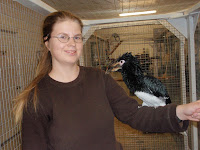Remember that pest control crew I wrote about last October under the title Insecticides? Well, they’re now hard at work and keeping the plant-devouring insects at bay in my backyard. A young Downy Woodpecker searching for insects in my ancient and now decrepit Hawthorn tree
In my previous article I talked about the types of food you could use to lure these hard-working exterminators to your yard. There are other things you can do to ensure that YOUR yard is the most inviting environment in the neighborhood!
A Nuthatch at one of our birdfeeders
Number One on that list is DON’T SPRAY FOR INSECTS! If you spray, you’ll be killing off the primary food source for these free pest control experts. I know, I know, it’s really hard to keep your hands off of the sprayer! RESIST! Instead of reaching for the sprayer—reach for the birdseed, or the suet.
A Brown Thrasher drying off after a dip in the birdbath
Number Two on the list. Install a birdbath—or two—in your yard. It doesn’t have to be a fancy one if funds are tight. It can be as simple as a plant saucer or other shallow container that you might have around the house. The key here is to hose it out every day so that mosquitoes don’t breed. If you want to get fancy, Wild Birds Unlimited sells a device called a Water Wiggler that keeps the water moving and discourages mosquitoes from laying their eggs. (They need still water for egg laying.)
Our now shady backyard with plenty of cover for our exterminators
Number Three. Provide habitat. You don’t have to live in a woods to have habitat. Many years ago when we first moved to our home it was a barren field. The six-foot oak trees that we planted forty years ago are now towering giants that invite the birds to perch, shelter, feed and raise their young. However, you don’t need to wait forty years to have trees that invite the birds into your yard. Hawthorn trees (the tree that bears the Missouri State Flower) are fast growing, have beautiful flowers when in bloom and produce a crop of berries that the birds love.
Doves are one of the most prolific backyard birds
The third year after we planted our Hawthorn tree we watched a dove raise six clutches of babies in this young tree. Yes, believe it or not, I said six! I know that’s an unbelievable number (we were amazed), and it’s the only time I’ve seen it. It was a long, very mild season, and she started the first clutch very early in the year, and was still sitting on eggs in late fall. The young were barely out of the nest and she was back to egg laying. My research says that in warmer climates Doves have been known to lay as many as five or six clutches. Guess she didn’t know that this is Missouri!
A flock of Cedar Waxwings may pass through in the Fall
Occasionally in the fall you may see a flock of Cedar Waxwings stripping the berries from your plantings as they make their way south. Of course you could also plant a Dogwood (our Missouri State Tree) for it’s beautiful Spring flowers and the Fall berries that the birds love.
There are any number of other landscape plants that will attract your exterminators – Pyracantha bushes, Lilacs, Ninebark, etc.
A Carolina Wren singing to attract a mate in the branches of a Hawthorn tree
Don’t forget low growing plants for the understory vegetation where birds such as Wrens, Sparrows and Brown Thrashers love to hunt. For more information on plants suitable for your landscape click HERE for the Missouri Botanical Garden’s “Grow Native” website. If you do not live in Missouri, contact your local botanical garden for information on non-invasive plants or plants native to your area. For more information on invasive species go to the USDA National Agricultural Library or the U.S. Arboretum websites.
Number Four. It’s still nesting season for some species. Help them along by providing nesting materials. A new technique I’ve tried this year has worked beautifully. I have a dog that sheds unbelievably. When I brush him I take the hair I’ve just removed from the dog, and stuff it into an old suet feeder that sits in my backyard. The birds love it! They are regular customers at my “hair feeder”. I’ve since discovered that stores that carry birding supplies sell a “nesting ball” which is essentially the same thing—only it’s round.
A baby Downy Woodpecker learning to perch on the Hummingbird feeder for a drink of sugar water
Had I kept up the spraying routine that was standard practice when we bought our home I would not now be watching the young Downy Woodpecker perching on my Hummingbird feeder to get a drink, or the Brown Thrasher baby following mom like a shadow, waiting for a tasty morsel. I would be out there with sprayer in hand, once a week, fighting the chemical blowback caused by the wind, and in the end would end up with a sterile yard with no wildlife and “moth eaten” plants.
A view of the backyard showing some of the understory plants the birds love
As I sit on my patio with my cup of coffee in the morning and watch my exterminators hard at work, I thank my lucky stars that I learned long ago to keep my hand off the insect sprayer.
Submitted by Gay Schroer, World Bird Sanctuary Volunteer





























.jpg)




















